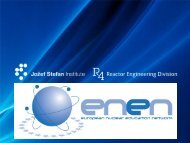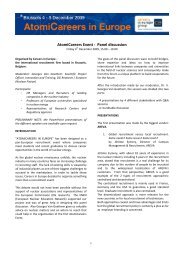Annex I Description of Work (April 2007) - ENEN Association
Annex I Description of Work (April 2007) - ENEN Association
Annex I Description of Work (April 2007) - ENEN Association
- No tags were found...
You also want an ePaper? Increase the reach of your titles
YUMPU automatically turns print PDFs into web optimized ePapers that Google loves.
Euratom 2005-6 – Fixed deadline<br />
Coordination Actions<br />
<strong>ENEN</strong>-II<br />
The INSTN co-ordinates various PhD programmes at the CEA, which hosts approximately 600<br />
young scientists preparing doctoral theses in its laboratories. Research topics include all CEA areas<br />
<strong>of</strong> expertise: physical sciences, life sciences, advanced technologies, nuclear reactors, fuel cycle,<br />
defence activities, protection and nuclear safety, scientific and technical information, etc.<br />
Every year, about one hundred foreign students register for the different courses <strong>of</strong>fered by the<br />
INSTN. They are admitted under the same conditions as French students, if they have received<br />
sufficient basic training (assessed by the equivalence <strong>of</strong> diplomas or by a prior examination) and if<br />
they are fluent enough in French. In parallel, the INSTN also organises, in French or in English,<br />
courses <strong>of</strong> four to six weeks for high- level experts from developing countries, jointly with the<br />
International Atomic Energy Agency (IAEA). Furthermore, specific seminars in English, are<br />
organised by the INSTN within the framework <strong>of</strong> the <strong>ENEN</strong> <strong>Association</strong> to meet the needs <strong>of</strong><br />
foreign Institutions.<br />
Finally, apart the various bilateral programmes with different foreign countries, the INSTN has<br />
participated and is still participating in Tempus programmes for the improvement <strong>of</strong> the educational<br />
system in Romania.<br />
Joseph Safieh : PhD in Physics, Engineer in Genie Atomique. Present Position : Head <strong>of</strong> the<br />
Nuclear Education Department <strong>of</strong> INSTN. Contractor in <strong>ENEN</strong> project. Representative <strong>of</strong> INSTN at<br />
ANS. C<strong>of</strong>ounder and current President <strong>of</strong> the <strong>ENEN</strong> <strong>Association</strong>.<br />
Partner 20 Helsinki University <strong>of</strong> Technology (TKK)<br />
Helsinki University <strong>of</strong> Technology (TKK) is the oldest and largest university <strong>of</strong> technology in<br />
Finland, dating back to the nineteenth century. In 1849 the Helsinki Technical School was founded,<br />
marking the beginning <strong>of</strong> organized technical education in Finland. In 1872 the school became<br />
Helsinki Polytechnic School and in 1879 Helsinki Polytechnical Institute. In 1908 it was changed to<br />
Helsinki University <strong>of</strong> Technology and thus began the teaching <strong>of</strong> technology at university level in<br />
Finland. In the 1950's and 60's new premises were built to house the University <strong>of</strong> Technology in<br />
Otaniemi and the university moved from Helsinki to the neighboring city <strong>of</strong> Espoo. TKK is twelve<br />
faculties, ten separate institutes, 17 degree programmes, 246 pr<strong>of</strong>essors, 14 763 under- and<br />
postgraduate students (2002) , 940 Masters´ degrees awarded and 195 doctorates (2002), Total<br />
funding from state and other sources Euros 189 million euros (2002).<br />
In Finland MSc-level nuclear engineering education is provided by two, roughly equally sized units:<br />
Helsinki University <strong>of</strong> Technology, Department <strong>of</strong> Engineering Physics and Mathematics, Advanced<br />
Energy Systems (AES) and Nuclear Engineering Laboratory <strong>of</strong> Lappeenranta University <strong>of</strong><br />
Technology (NEL/LUT). AES focuses on reactor physics, radiation topics, and environmental<br />
assessments whereas NEL/LUT has its strongest expertise in thermohydraulics. Strong collaboration<br />
between AES and NEL/LUT exists. AES gives basic nuclear engineering education to about 30 3'<br />
year students <strong>of</strong> TKK (study programmes <strong>of</strong> engineering physics, electrical engineering, mechanical<br />
engineering) and to about 10 more advanced students within the study program <strong>of</strong> Engineering<br />
Physics AES is also involved in research and education on wind, solar, and renewable, novel energy<br />
storage methods, and fusion research. The strategy is to provide the students a strong physics and<br />
mathematics background and a "researchers" attitude applicable to tackle the multifaceted problems<br />
in energy problems. For more details, see our web-site http://www.hut.fi/Units/AES/.<br />
<strong>Annex</strong> I <strong>Description</strong> <strong>of</strong> <strong>Work</strong> - page 100 <strong>of</strong> 124








